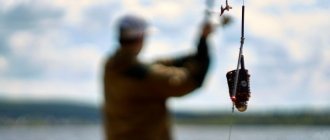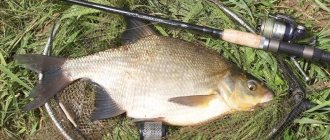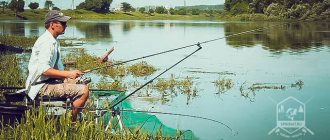Vladimir Klen | October 24, 2021
With modern bottom gear you can purposefully and successfully catch not only peaceful fish, but also predatory ones. This is especially true in terms of hunting for such active schooling fish as perches.
When mastering any new type of equipment, every angler initially has a desire to simply catch fish with it - regardless of the type and size of the latter. However, as you master the gear, acquire skills and experience, you develop the ability to catch not just anything, but specific varieties of fish, sometimes even with given characteristics. Feeder tackle with its widest range of applications is no exception.
Practice convinces us that with this sensitive donkey you can catch absolutely everything, from small bleak to trophy carp or catfish. But, despite this, the feeder is still more often associated with catching fish that are considered non-predatory - bream, roach, silver bream, crucian carp, carp, etc. Less often, people go with him to catch omnivorous fish, such as chubs or, say, barbel. Well, predatory fish - pike, perch, pike perch, asp - are considered the exclusive domain of spinning anglers or those who like to fish with live bait.
Of course, such a division has a basis, but the capabilities of modern equipment, with a competent approach and the availability of appropriate skills, allow us to erase stereotypes. The same bream and carp today are successfully caught with a spinning rod, and perch not only with a float rod, but also with a feeder.
Links
If you look at it, it is not surprising that striped predators are an excellent object for bottom fishing with a feeder. Moreover, one can even give a number of arguments in favor of the argument that they are directly created for feeder fishing - and in some cases, donka will give a head start to other types of equipment in the hunt for striped fish. I will give arguments.
Firstly, these fish live in large numbers and occupy almost all reservoirs and watercourses. They lead a sedentary lifestyle, without making serious migrations, and therefore calculating the places of their concentration is not a problem. Small perches can be easily found near bridges, swimming pools, piers, piles and other structures.
Preferring coolness, on hot days they stand under steep banks near flooded bushes, under tree branches hanging over the water, in the shade of aquatic vegetation. Accordingly, the chance of catching them is no less high than the ubiquitous roach. As for the feeder rod itself, in “strong” places it is sometimes preferable to a fishing rod, float or spinning rod, when used in a limited space the number of hooks is quite high.
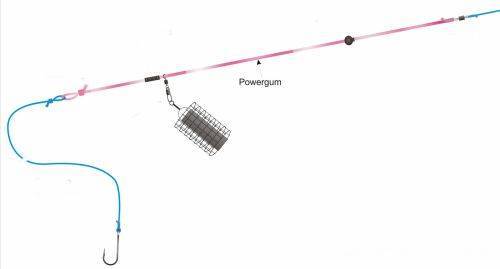
Secondly, perches are omnivores. It is known that in water bodies rich in benthos, not only juveniles, but also large individuals continue to feed on larvae throughout their lives. By the way, perches aged 4–6 years of life are considered to be pronounced predators, and this despite the fact that perches reach half a kilogram size by 7–8 years.
Thirdly, they are perhaps the most voracious fish. Experts say that the waking phase of well-fed perches coincides with the active phase of hungry ones. Therefore, by properly feeding the fishing point, you can quickly attract the attention of fish and then count on systematic success in catching them.
Fourthly, perch are active throughout the year, and in early spring and autumn they can be successfully caught all day, especially if the weather is cloudy.
And fifthly, it is the feeder from the shore that is the easiest to reach deep-sea areas where perches move for the winter in the fall. And there, in pits and pools, humpback perches are found all year round, leaving them only in the mornings and evenings for a short time in the summer. And on small rivers, perches again accumulate in holes and widenings of the channel, near riffles, waiting for prey carried by the current.
Fishing for perch with a spinning rod in September
September, natural smooth climate transition. At this time, the perch still behaves in summer mode. Actively chases fry, feeding from the surface during hours of maximum water heating.
There are several active phases of fishing. Morning, the fish is closer to the depth of its usual habitat, daytime, active fishing in the upper part of the water surface, and evening, the fish sinks lower.
At this time, all types of usual baits from silicone to wobblers are excellent. Catching perch in September does not seem to be a particularly difficult task.
On warm days, you can see fishermen right within the city, who are en masse catching the ubiquitous striped predator, and in small rivers and city ponds.
First meeting

For the first time, while fishing with a feeder, I came across a perch bite, without expecting it. That day, despite all my efforts, neither the bream nor the white bream were active. Having tried different options for changing this position, I finally decided to use bloodworms and chopped worms instead of the bait mixture, except that I clogged the feeder filled with them with porridge on both sides so that the two-component bait would not fall out. I poured such portions into the catching point of the heels - and soon I saw a barely noticeable twitching of the tip. I hooked it carefully and felt a pleasant resistance on the hook. I thought that I still waited for the bream’s reaction, and my prey seemed to match it. True, I thought so until it appeared in front of my eyes - it was not a bream at all that entered the set-up landing net, but a rather large perch.
Such a trophy was somewhat discouraging, but did not look sensational, because in winter not only small perches were regularly and well caught from the ice in this water area, but also humpback whales jumped through. Therefore, considering the success not accidental, I continued fishing. As a result, in a few hours the fish tank was filled with several dozen perch, which were diluted only by a few roaches caught during the period between the striped ones.
Using the feeder on different water bodies, over time I noticed that perch can indeed constitute not only the by-catch, but also the main catch. Moreover, I figured out several places where they are effectively caught from the bottom with enviable consistency and even better than other fish. The collected information allowed us to form the following ideas about the “feeder” perch and the equipment that is optimal for catching it.
Feeders for winter feeder
The design and weight of feeder feeders used in winter fishing are responsible for delivering the entire portion of food to a given point. Even when hitting the water, the bait should remain inside the feeder and the dusting effect should be avoided. Plastic mesh feeders are used in weights from 80 grams and above, depending on the fishing range.
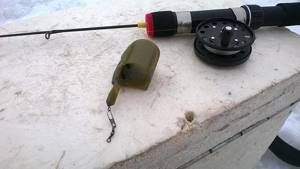
Closed-type feeders used for delivering animal components such as bloodworms or maggots to a point are also convenient. But you need to be careful about actively feeding natural baits, because there is a risk of overfeeding the fish and “killing” the point. In addition, there is competition between the groundbait and the bloodworm attachment, which is advisable to avoid.
The function of bait is to attract fish, and the bait becomes an appetizing “cherry on the cake” that neither bream nor crucian will refuse. Plastic feeders are highly buoyant, they are easier to operate at low temperatures and there are no problems with food delivery.
Snap on striped
I don’t see any point in making special demands on a feeder rod used for catching perches. I focus on fishing conditions: current, wind strength, casting distance, characteristics of the water area, etc. However, the issue of feeder sensitivity is not secondary. The bites of a seemingly predatory perch are most often timid and weakly expressed, so when using a hard tip you can simply not notice them.
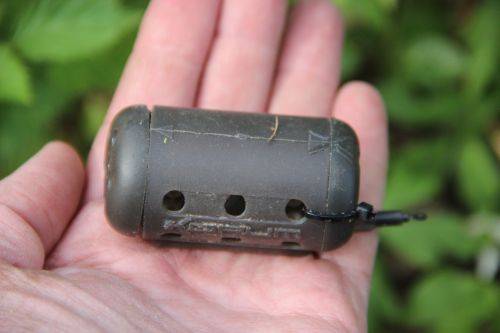
But when playing, a striped fish does not always give in without a murmur, so a well-cushioned form and a flexible, sensitive tip will ensure both effective hooking and minimize derailments. By the way, I noticed that several empty bites or gatherings can lead to the cessation of biting. I cannot explain the reason for this phenomenon, but it does not bring pleasure.
If possible, the feeder can generally be replaced with a more “slender”, sensitive and shorter picker, which will simultaneously increase the fishing speed with high casting accuracy, and will also allow you to more quickly change fishing spots in the event of a perch school moving from the original point or even finding a new school.
The best option for transmitting bites is provided by a cord, so I equip the reel with it. A thickness of 0.08 - 0.10 mm is sufficient. However, the disadvantage of the cord is that it reduces the shock-absorbing properties of the equipment. As a result, weak perch lips are often torn by the hook, which can then fall out of the fish’s mouth. This problem is mitigated by the use of a shock leader or insert from a feeder-gum (power-gum) in the equipment. When fishing for perch in lakes at long distances, such options are justified.
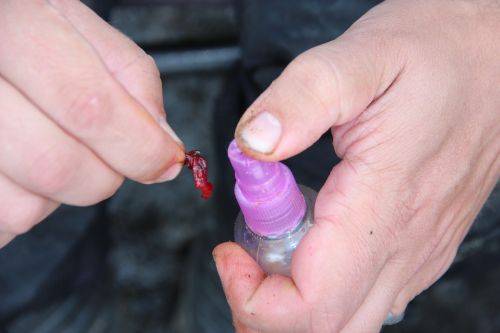
Well, when using a picker and casting at short and medium distances, you can use a non-rigid fishing line instead of braid. In this case, additional elements will not be required.
As for the leash, we should not forget that, as a representative of predators, perch is capable of damaging the fishing line with its small teeth. Therefore, a leash 50 - 70 cm long made of fluorocarbon fishing line seems to be the most preferable. Unless, if it is necessary to ensure the slowest, smooth immersion of the bait, which appeals to the perch, you need a regular fishing line, which is half the weight of fluorocarbon.
The last mentioned circumstance is reflected in the type of equipment installation. I prefer to use a Gardner Paternoster or a "helicopter" with two knots. They are the ones who are better than others at registering bites on a fall, while remaining virtually universal. Well, an alternative to a hook can be a jig.
Considering that to attract attention and collect perches at one point, food is used not of plant, but of animal origin - chopped worms, maggots, bloodworms, crushed shells, etc., it is better to select a feeder that either minimizes their loss during immersion (such as a river feeder ), or container type with closed ends and openings in the body. However, at a short fishing distance, the feeder will give way to a bottom sinker, and feeding with this option is done with a slingshot or even by hand.
Groundbait and lures
Above, I already mentioned a successful option for feeding perches.
This is the path I am going. Along with the animal component, I add to the complementary food not only the standard nutrient mixture, but also soil mixed with it, which creates a turbidity in the water that is attractive to perches - after all, the task of bait is to attract the attention of perches to the place where the equipment is immersed. I don’t want to keep them with a large amount of nutrients. If the perches approach, they will certainly react to the bait. Therefore, especially when fishing in shallow waters, after pouring several portions of food from a large feeder into the fishing area, I subsequently replace it with the smallest possible feeder. It minimizes the noise that frightens perches, makes the equipment more delicate, simplifies working with it, and reduces the number of idle hooks.
The classic feeder trio of animal baits - bloodworms, worms and maggots - also leads when catching perches from the bottom. They can compete with leeches and lamprey larvae (spindles). It’s good when there are, if not all of the specified types, but at least several of them. I know lakes where perches are caught exclusively with bloodworms, but there are also places where, contrary to logic, they give priority not even to it or the worm, but to maggots. Moreover, the larger the bait, the higher the chance of catching a large individual. Therefore, a sandwich constructed from several types of moving bait will come in handy.
Treating the bait with flavorings gives a good attractive effect. Moreover, as practice shows, the appetite of perches is stimulated not only by dips with animal or fish scents (“Predatory fish”, “Perch”, “Squid”, etc.), but also by vegetable ones (vanilla, hemp, cinnamon, etc.). I do not exclude that the answer to this phenomenon lies both in the relative constancy of the use of certain odor baits by fishermen on a particular body of water, and in the novelty of the odor. I consider perch and crucian carp to be the most curious inhabitants of the depths.
The option of baiting a fry on a hook is not excluded, but this fishing is still from a different story, so I see no reason to pay attention to it when fishing with a feeder. It is more important to note that after casting the equipment, you should wait until the bait sinks to the bottom. If there is no bite on the fall, you should not passively look at the quivertip. Catching perch requires active action on the part of the feeder himself. Moreover, it is better to hold the rod in your hand and perform short stretches with it. In this case, the bait moves along the bottom, simultaneously raising turbidity and exciting the perches looking at it. It turns out something like wiring a “balda”.
Considering that every year manufacturers of artificial fishing baits increase their varieties, at the same time imparting a smell and achieving maximum similarity to the prototypes, I had the intention of trying out such baits in feeder fishing. And specifically with a focus on perches, because I believe it is impossible to do without setting imitations into motion. However, this will be a completely different story.
Source: sfish.ru
Pike
The best way to catch pike on a feeder is with live bait. Thus, you can catch trophy pike specimens in the bottom layer. When you catch and feed white fish with a feeder, its accumulation is very attractive to individual pike specimens. Here the toothy one doesn’t know whether it’s live bait or a real fish.
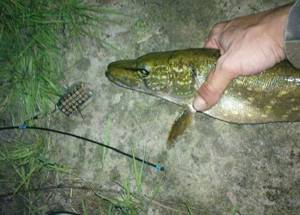
Got a toothy one
It will not be very successful to specifically, purposefully catch a predator with such gear as a feeder. But mixed with other types of fish, as by-catch, so to speak, you can catch pike. For fishing with live bait, a regular float is used. You can watch the proposed video of how pike fishing happens.
Pike is a very strong fish, it will fight. Therefore, if your tackle is powerful enough, then you can not only wait for the pike to bite, but also pull it out so that it does not fall off the hook.
Perch
I want to say that I didn’t come across a lot of pike on the feeder, but of the predators, perch bit the most. This voracious fish feeds all year round, so while fattening, it sometimes begins to grab small minnows baited as live bait. Where peaceful fish feed, there are schools of perches right there. So fishing on a feeder is quite capable of attracting schools of perch.
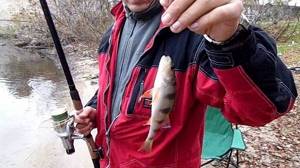
Such a perch can get caught on a hook
Perch fishing tackle
On the feeder line there is placed a leash, about 40÷50 centimeters, a sinker that slides and a float. If you fish at a sufficiently deep depth, then the float should be sliding. If the cast is close, the float can be tied tightly. The float setting will depend on the casting depth. Also, its attachment location will be determined by the current, whether there is a current or not. In any case, when tying a float, you must first cast the rod without bait and watch it.
Since predators behave very actively on the hook, constantly resting and resisting, there should be no fixation of the fishing line, otherwise there will be a break. Instead of a sinker, you can use a small feeder filled with the same food as on the hook.
As with any fish, the rule for catching a predator on a feeder is that as little fishing line as possible should be in the water.
The fishing rod must sense even weak fish bites, so it is very important to equip it with a thin tip. Otherwise, you may simply not notice light perch bites.
The gear for catching perch can be a “helicopter”. This tackle is used if you need to play along with bait when the feeder is stationary. It is used for long casts.
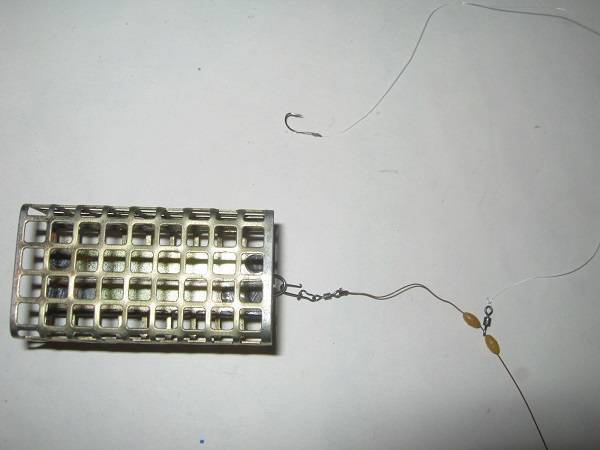
Equipment "Helicopter"
Everyone understands that neither perch nor pike are feeder fish. But small perches are often caught on the feeder. They resist quite stubbornly, such fishing will be exciting and not at all boring. Large specimens of fish are much less common. If no prey is caught, then you can catch small perch so as not to come home empty (or as a sport).
Feeding tactics
Catching perch is not as easy as it might seem at first glance. Its bite is often very capricious, and the bites are careful and barely noticeable. In addition, perch is quite shy, and large feeders can alert or scare away a school, so perch are caught using small “thimble feeders” that quietly enter the water and do not scare the fish at the bottom. In most cases, a lot of bait is not required, only a constant supply of live components is important.
Read! Tips for catching carp on a feeder
Before starting perch fishing, as a rule, a massive starting feeding is not required; it is enough to “mark” a point with a couple of medium feeders with a large amount of animal component. After all, we are not faced with the task of feeding the fish; we need to attract it and try to catch it.
When is a feeder needed?
Sometimes the perch is at depth, but you can’t cast the spinning rod far. In this case, a feeder can come in handy. Such tackle will help out if fishing is carried out in heavily overgrown areas of the reservoir, and there is no other way to catch this fish. If we take into account that perch hunts from ambush, then such thickets will be the main hunting ground for this fish.
With the help of feeder gear, bait can be delivered to the desired location. For a predator like perch, heavy equipment is not necessary; lighter weights can be used.
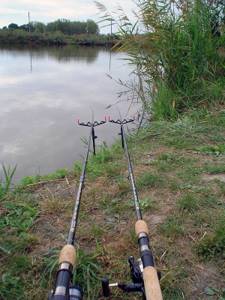
Waiting in the wings
Passive fishing for predators will not work. You will have to constantly move the tackle, pull it up, the perch loves any movement. Moving the rod will cause the bait on the hook to move.
When and where to catch perch in the fall
To begin with, it is necessary to highlight such a factor as current. It is fundamental and determines the nature and habitat of the perch. As you know, all reservoirs are divided into two types:
1. Rivers (natural flow), reservoirs (flow regulated by hydraulic structures).
2. Reservoirs that do not have a current (lakes and ponds).
In relation to rivers and reservoirs, several characteristic habitats can be distinguished:
1. Coastline of aquatic vegetation adjacent to clear water.
2. Extensive shallow waters without sudden changes in depth.
3. Old flooded streams adjacent to the riverbed.
4. Places of confluence of small rivers, exits from oxbow lakes.
5. Any flooded individual snags, stumps located at a depth of up to 5 meters.
6. River sections after rapids.
If we are considering lakes and ponds, then we need to consider the following places:
1. Coastline with grassy vegetation.
2. Any changes in relief at a depth of up to five meters.
3. Lake bays.
4. Man-made structures (dams, bridges).
5. Places where streams flow.
As for the fishing time, it’s definitely during daylight hours; at night the perch is not active. The most favorable times for successful spinning fishing are dawn, midday, and just before sunset.
Lure
Perch needs a special complementary food that contains an animal component. For example, he is interested in bloodworms, cut worms and maggots.
If fishing for perch takes place on a feeder, then odorless complementary food is usually used. Although some experts allow the addition of flavorings with the smell of a worm. The bait should be dark, black in color and must contain bloodworms. You don’t need a lot of bloodworms; you need to feed them in small portions. Lures are thrown traditionally, using a slingshot.
When the feeder is thrown, a cloud of turbidity forms. This dregs attracts a flock of striped predators. Some species of fish, for example bream, can only be scared away by this turbidity. But the perch is not one of the timid ones; it rushes at any movement. To form such a cloudiness, you need to add a little finely mashed bread or potato mixture.
In principle, catching pike and perch on a feeder is very possible, only it will be a different kind of fishing, different from catching peaceful fish.
Folk sign: Before fishing, no one should wish you: “No tail, no scales,” otherwise there will be no bite!
Source: KakUlov.ru
The essence of using a predatory feeder
Feeder fishing implies the mandatory use of bait, which in its usual form is not particularly interesting to the predator, therefore the feeder in catching predatory fish can be used in three options:
- with bottom live bait equipment, when the feeder gear is used simply for casting live bait and landing fish, that is, we are not talking about the feeder as a method of fishing, but about the use of feeder gear in the live bait bottom;
- in the version with a feeder, in which the bait is used to attract small fish, which, in turn, attracts a predator;
- in the classic version for catching perch and a number of semi-predatory fish, for example, ide or chub.
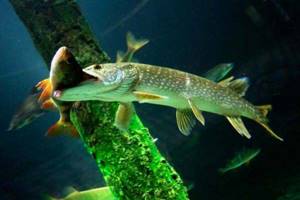
One of the most popular is the predatory feeder
Fishing for perch with a spinning rod in October
At this time of year, there are fewer warm days. The average water temperature drops by 10, 15 degrees from summer levels. Perch stops being active all day long and gathers in schools on the terrain.
The busiest hours are just after dawn and just before sunset. The predator is most active at this time and responds well to artificial baits. Classic jig fishing comes to the fore. Moreover, both coastal fishermen and boat fishermen. The fish become lower in the water horizon, but there may be more of them. October is a schooling time for many predators in our waters.
In October, you can increase the standard size of baits, which is due to the fry that have grown since the summer. The food supply determines the preferences of the predator. It is not uncommon to catch perch when purposefully fishing for pike perch and pike; all this indicates a change in the habitat horizon and autumn aggressiveness.
Correct installation of feeder equipment on a predator
Installation of a predatory feeder differs from conventional feeder equipment. The main requirements for it are:
- ensure freedom of movement of live bait or the play of other bait in the current;
- eliminate overlap and tangling of equipment;
- ensure a high rate of bites and eliminate the loss of fish when playing.
Most often, a sliding rig or paternoster is used to catch predatory fish, but the use of an anti-twist is also acceptable. The diameter, material and length of the leader, as well as the size of the hook, depend on the type and size of the intended catch. In the case of using large live bait or dead fish as bait, the use of tackle with two or more hooks is justified.
How to properly catch a predator on a feeder?
When catching predators on a feeder, live bait is most often used as bait, which places special demands on casting gear. Vigorous casting over a long distance will lead to the death of live bait, which will greatly reduce the likelihood of a bite. Therefore, catching predatory fish on a feeder is most often carried out at short distances, especially since they most often come to the coastal zone to feed.
There is no need to rush to hook when there is a bite; it is better to take a short pause and allow the fish to swallow the bait.
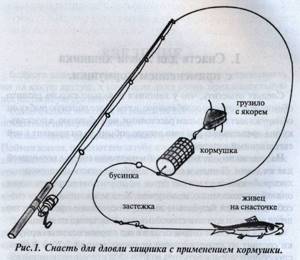
Some fishermen tie rigs directly on the line, making knots to limit the movement of the feeder
Landing fish is usually not a problem, except for biting very large specimens of catfish, pike or pike perch.
The principle of catching pike on a predatory feeder
For catching toothy predators, the most effective and practically the only suitable bait is live bait. Widespread fishing in Western Europe with dead fish is explained by the peculiarities of legislation that prohibits the use of live fish as bait.
When making a rig for catching pike on a feeder, it is necessary to take into account that due to the peculiarities of its anatomy, it is more convenient for a pike to attack prey located above it or at the same level. Thus, it is desirable that the live bait swims at some distance from the bottom. This can be achieved by including a small float made of cork or foam into the equipment.
In the case of targeted pike fishing, a metal leash is used in the equipment. If a pike bite is possible when fishing for other fish, it is better to stick with a fluorocarbon leash.

The most effective way is with live bait
The principle of catching pike perch on a predatory feeder
Pike perch is often caught as bycatch when fishing for bream or roach, especially in spring. With a purposeful feeder, pike perch can be caught using live bait, dead fish, or “cutting” - narrow strips of fish fillets, cut off with skin and scales. It is desirable that there is a fin on the strip. As live bait, it is better to use fish with a narrow body - gudgeon or goby. Bleak, being the favorite food of pike perch, dies too quickly on the hook and requires frequent replacement.
Installation for catching pike perch is not complicated - a sliding sinker or feeder of a weight suitable for fishing conditions, a swivel and a leash made of monofilament or fluorocarbon 0.2-0.3 mm and 50-70 cm long. The hook must be very sharp, given the hard mouth of the pike perch.
The principle of catching perch on a predatory feeder
Perch, being a pronounced predator, feeds not only on fish, but also on various aquatic invertebrates, so it can be caught using both live bait and a classic feeder.
Live bait rigs for perch differ from rigs for pike and pike perch in that they have a thinner fishing line and leader, as well as a smaller hook.
Catching minke whales with a feeder is carried out using baits of animal origin - a worm, bloodworms, a leech, and less often maggots.
It is important to use a large number of components of animal origin in bait, as well as the use of flavors with the smell of shrimp, mussels, and bloodworms. You can use fishmeal as a budget-friendly substitute for flavorings.
How to catch perch: tackle, live bait fishing, spinning, feeder, winter fishing
Perch fishing is one of the most common types of fishing. This fish is so common in our latitudes that it is found in almost any fresh water body from Northern Asia to Western Europe and America. Perch is a very active schooling fish, characterized by particular greed and gluttony, so it always bites, regardless of the time of day, weather and temperature. In this regard, the hunt for this striped robber does not stop all year round.
River perch habitats
Perch prefers calm, flat water bodies, regardless of their size and depth. Being a predatory fish, schools constantly move in search of food and cover considerable distances.
In total, three types of perch are known: European (regular or river), Balkhash and yellow. We have only river fish, which are also divided into 2 subspecies: shallow-water minke whale (sailor) and humpback whale, which prefers depth. The favorite places of the “sailors” are coastal reed thickets, snags and backwaters overgrown with algae. The humpback whale, on the contrary, lives and hunts exclusively in deep pools and holes.
What does perch hunt for?
The diet of the striped predator varies depending on its age, geographic location and zoosphere of the reservoir. This factor must be taken into account when preparing for fishing in order to select the optimal bait option. The main diet of perch consists of:
- plankton;
- insect larvae;
- earth and river worms;
- leeches;
- tadpoles and frogs;
- small crustaceans;
- fry and small fish;
How to find a place to catch perch
Determining a place to catch perch is quite simple. It’s better, of course, to use an echo sounder (onshore or for a boat) - it will show the bottom topography and identify a school of fish. If such a device is not available, pay attention to the shallow coastal waters, where schools of fry are visible. If there are thickets of algae, overhanging or fallen trees near this place, look for the striper there. You should look for humpback fish at changes in depth, on rocks, in places where streams and rivers flow into a body of water, or where there are accumulations of branches and logs.
To settle in stagnant bodies of water, perch often uses thickets of water lilies and sedges located far from the shore. In running water, both humpback and minke whales prefer to stand in small creeks, snags, and at river bends, where there is practically no current. As a rule, perch hunts in the morning and evening, going out into open water. Its presence can be recognized by the “boiling” water created by the chasing fry.
In autumn, perch moves to depths where the water is a little warmer. Its activity usually slows down in November, but with the first ice you can again catch striped fish in the same places.
What to catch
Depending on the type of reservoir, its characteristics and time of year, perch is caught in different ways and with different gear:
- float rod with an attachment in the form of a live fry, worm, larva or piece of meat (spring-autumn);
- spinning rod equipped with a spinner, wobbler or silicone bait (spring, autumn);
- predatory feeder (summer, autumn);
- winter fishing rod (winter);
Fishing with live bait
Catching perch with a float rod using live bait is a classic, inexpensive and effective method that has proven itself. Fishing with a fishing rod has an advantage over spinning fishing for perch due to the fact that it makes it possible to fish in snags and places overgrown with algae. For this purpose, you can use the most ordinary fishing rod with float equipment and a reel. There are no special requirements for coils; any type of coil can be used.
The choice of equipment depends on the expected catch, but it is advisable to use a fishing line with a thickness of at least 0.25 mm. The type and dimensions of the float must correspond to the selected load. Depending on the location and bottom topography, both a “dead” (immobile) float and a sliding one are used. When choosing a hook, it is better to give preference to products with an elongated shank, which will simplify the placement of live bait.
The bait used is fry of common freshwater fish - roach, silver bream, crucian carp, as well as small fish such as bleak, bitterling, smelt, perch or gudgeon. The future bait is usually caught with a “bait”, which is a net with a small cell, stretched on a cross according to the principle of a “spider” tackle. With the help of a fishing rod or a long stick, the “little fish” is lowered into the intended fishing spot, which is then fed. After some time, the net is lifted and the fry is taken out. Live bait is usually kept in a bucket of water from the same body of water as the fish.
Attaching live bait to the hook: 1 - leash; 2 — fastener; 3 — fore-end; 4, 5 — nodes; 6 - double
For fishing with live bait, a single hook is most often used. There are several ways to place live bait on a hook:
- for one or two lips;
- behind the nostrils;
- behind the back under the upper fin;
The first two methods are simple and provide the bait with long-term viability. However, there is a possibility that a predator, having grabbed its prey, will simply rip it off the hook. A more reliable, but more complex method is to place it behind the back. The main thing in this procedure is not to catch the fish’s spine, otherwise it will simply die. It is also important to correctly cast a fishing rod with bait in a smooth but confident manner, so that the bait does not fall off and the tackle ends up in the chosen place.
On the river, it is better to fish with live bait from the shore, going upstream, choosing places with a reverse current, the presence of snags and thickets. In reservoirs it is better to hunt from a boat near island channels and thickets, as well as near the shore on overgrown shallows.
How to increase your fish catch?
Over 7 years of active fishing, I have found dozens of ways to improve the bite. Here are the most effective ones:
- Bite activator. This pheromone additive attracts fish most strongly in cold and warm water. Discussion of the bite activator “Hungry Fish”.
- Increased gear sensitivity. Read the appropriate manuals for your specific type of gear.
- Pheromone-based lures.
Spinning fishing
When catching perch with a spinning rod using a spoon, experienced fishermen most often use light-class rods with a test load of 10-15 g or ultra-light (up to 10 g) for micro-spinners and spinners. The length of the spinning rod should not exceed 2.5 m. As for the reel, it is best to use an inertia-free one. You should not spend money on expensive types of rods or reels, because the success of fishing depends not on the cost of equipment, but on the skill of the fisherman.
Choosing bait is not an easy task, since in terms of the variety of spinners, wobblers and other baits, perch hunting is superior to pike perch or pike perch.
The most popular bait is the cicada or bladebait. The behavior of such bait in the water column instantly attracts the attention of an active predator. Using a “cicada” as bait, you can use any type of wiring from jig to uniform.
In summer and autumn, fishing with an oscillating spoon or spinner with deep stepped wiring is also popular. This method of spinning tactics gives good results, but is only applicable on reservoirs with a clean sandy bottom.
Jig head with "feather"
The best option for spinning fishing in reed thickets is to use a small spinnerbait (a jig head with a hook and a variety of “feathers”). For such a nozzle, the best type of wiring is uniform, which allows you to keep it at a depth not exceeding 1.5 m. You can also use a fast retrieve to keep the spinnerbait at a minimum depth.
It is better to fish with a spinning rod in the morning or at sunset. Calm, windless weather and light clouds are the best conditions for perch hunting. In rain and strong winds, perch does not hunt, but at this time prefers to sit somewhere in a secluded place.
When fishing with a spinning rod, you should take into account that perch is a very playful fish and attacks with lightning speed, so be prepared for the fact that the spoon will be attacked when casting before it has time to sink to the bottom. Pulling up and landing a small predator is not a particular problem, since the perch almost always swallows the bait deeply. The likelihood of a derailment is thus reduced to a minimum. But if you had to hook a humpback whale weighing 1-1.15 kg, you need to be extremely careful, because such a specimen is capable of breaking the tackle or taking it under snags and breaking it off there. To prevent this from happening, you need to make a hook immediately after the bite and begin to evenly pull the catch towards the shore.
We catch perch with a spinning rod: rigs, baits, fishing techniques.
How to catch perch with a float rod on a lake or pond?
Read on to learn how to catch perch on a retractable leash.
Fishing with a predatory feeder
Recently, predatory fish hunters have successfully used feeder gear for their purposes, which was previously used only for catching non-predatory fish. In itself, such equipment requires the presence of a feeder rod and a feeder, but some fishermen use its simplest version, consisting of the following elements:
- a regular fishing rod with a sensitive tip;
- coils (preferably inertia-free);
- main line with a thickness of at least 0.2 mm;
- a weight weighing 50-150g, secured through a swivel at the end of the main line;
- several leashes made of 0.08 mm fishing line, 15-25 mm long, located at a distance of 30-40 cm from each other.
Live bait, spinners and silicone baits are used as bait.
You can also use a feeder, placing it instead of a load or together with it. Fish meal, pieces of liver, and fish meat are suitable as food. All this is mixed with porridge or other types of bait. Meat components attract predators, and porridge attracts non-predatory fish, thus bringing them together. Approaching the feeder, the perch sees a cluster of fry and begins to attack them. Dead fish are also suitable as live bait for feeder gear. Often fishermen make cuts on it to attract predators.
Having cast to the right place, you need to wait for the tackle to sink and tighten it a little so that the line is in tension. The rod is positioned at an obtuse angle to the shore, almost vertically. The signal of a bite will be the movement of the rod tip. You can also use a bell or electronic alarm. Casts are repeated every 20-25 minutes.
You can catch perch using feeder gear all year round, even in winter in ice-free areas.
Perch fishing in winter
As soon as the first ice sets in, winter fishing begins. After a short autumn “rest”, which lasts about a month, the perch actively hunts. Thousands of fishermen, taking with them tools for drilling holes and winter gear, rush to the frozen reservoirs. Perch is the most common fish for winter fishing. There are even sports ice fishing competitions for this predator.
The choice of place for fishing depends on the time of ice formation. During the first ice, perch gathers on coastal shallows, small bays and beaches. But after 2-3 weeks the fish goes to depth.
Holes begin to be drilled perpendicular to the shoreline. The distance between them depends on the bait: for a jig it is 3 meters, for a spinner -5, and for a balancer - 10. Next, to determine the location of the perch, you should fish the holes and find the very place where the bite is most intense.
The most popular gear for this type of seasonal fishing is a winter fishing rod, about 20 cm long, equipped with a bite alarm - a nod and a reel. The nod can be purchased complete with a fishing rod or separately. Some fishermen prefer to make it themselves from a thin steel rod, plastic or spring. A good nod when biting bends at an angle of 30-450. For winter fishing, taking into account the transparency of the water, a thin fishing line of 0.1-0.15 mm is used.
The bait most often used is a jig - a small hook fused into a painted lead or tungsten weight. Experienced fishermen, when going fishing, take with them several types of jigs. The hook is baited with bloodworms, worms, dragonfly larvae, caddis flies or pieces of fish.
- sports jig (which does not require bait);
- balancer (small wobbler with a large oscillatory amplitude);
- vertical spinner.
There is no special fishing technique for jigs.
It simply descends to the expected depth of the fish. Sometimes, in order to attract the attention of a perch, you can twitch it up with a small amplitude and sharply lower it down. When fishing with a spinner, a retrieve is used in which the bait is lowered to the bottom, then rises sharply to a distance of 25-50 cm and again falls to half this length. The spoon can be equipped with a single, double or triple hook. When using a balancer, you should pay attention to its location relative to the fishing line. Unlike a wobbler, the balancer is attached to the fishing line not from the front, but from the back and must always be in a horizontal position. You can use any wiring, but it is better to start from the top, lowering the bait to the bottom, and having determined the depth, slowly begin to rise. If there is a fish, then the one on top will be caught first, which will allow you not to scare away the rest.
It is simply impossible to describe all the methods of catching perch. Considering that this predator leads a very active lifestyle and is constantly in search of food, catching it will not be difficult for a novice fisherman. But when going hunting for perch in summer or winter with any gear, you should remember that:
- the best bait for perch is a moving one;
- the perch does not stand in the same place, you have to look for it;
- perch is a very cautious fish, so you need to camouflage yourself as much as possible;
And don’t forget that fishing also depends on luck, so if you’re unlucky today, you’ll definitely be lucky tomorrow.
Poachers who caught 318 kg of fish were not punished
A group of fishermen revealed the name of the secret bait during interrogation.
Category: Regional news,
MORE DETAILS
primanki.com
Tips and tricks
Catching predatory fish on a feeder has a number of features that distinguish it from the usual use of feeder gear:
- the frequency of bites when catching a predator is low, with the exception of active schooling perch, which does not happen very often, so it is more effective to use several tackles thrown in different promising places or combine such fishing with other types of stationary fishing - a regular feeder, float, etc.
- You should not combine catching a predator with catching a large carp - biting at the same time will lead to the loss of one of the trophies, which will be very disappointing.
Source: rybalka.guru
With the onset of early spring, perch is rightfully considered the most active fish; it bites very actively and in large quantities. Basically, perch is caught on a spinning rod, since it is predatory, but the CIS feeders still decided not to be left without a catch in the early spring and therefore found ways to catch striped fish, which went back further into fishing - into the methods of our grandfathers, when perch I took it for a worm, not for food.

There is nothing complicated in this method - waterlogged complementary foods containing exclusively fine fractions, a biscuit or milky smell, a viscous consistency and the content of finely chopped worms. Hook - 12-14 numbers. The bait is exclusively a worm.
Regarding the location - shallow areas with well-heated water. Top 0.5-1 uz. Leash - 0.12-0.18. Also in Paul Elya’s manual it is said that perch can be caught with a slight twitch and installation - an asymmetrical loop. This creates a movement of the bait, which dictates the incitement to its attack, thanks to the predatory instincts of the perch. It is advisable not to dip the bait.
The main thing about this kind of fishing is to hook it in time; when a small perch bites, it is very difficult to see exactly when the perch swallowed the bait. The tip will help us with this - 0.5 uz, which is very sensitive and displays the slightest vibrations.
It is also possible to use chopped or live goby, ruffe or gudgeon as bait. The optimal length for leashes will be 40-50 cm. Perch almost always tries to stay away from the shore and in the most inaccessible places. The rig is naturally inline, but for a variety of fishing you can use a helicopter rig or an asymmetrical loop (if you want to try Paul Elya’s method). No tail, no scales!
Source: ProRybu.ru
Catching perch on a feeder
Technique for catching perch with a feeder
Most anglers who like feeder fishing usually prefer to catch peaceful fish, carp, bream, carp, silver bream, ide, roach, etc. with this tackle. However, catching perch on a feeder is no less exciting. And taking into account that this fish lives in large quantities in the vast majority of water bodies, it is quite successful.
Despite the fact that perch is a bright representative of predatory fish, its diet is mixed. Of course, perch is primarily a hunter and successfully hunts for fry and small fish. However, he also happily feeds on bloodworms, worms, maggots and various insects and their larvae. What makes fishing for perch with feeder gear very attractive.
Perch is an excellent competitor; even a specimen that is far from trophy size offers very active resistance, which naturally makes fishing for it very exciting. In addition, perch meat is very tender and there are few bones in it. Hot smoked perch is especially tasty.
Perch fishing
Small perch is usually a permanent inhabitant of bays and creeks, abundantly overgrown with a variety of aquatic vegetation. Medium-sized perch forms not very large schools of an average of 10-20 individuals, and its smaller counterpart flocks into schools that can number a hundred or more tails.
You can find perch on rocky ridges, near underwater edges, near bridge piles or large stones. This fish has excellent protective coloring and is almost invisible in the water, which greatly helps it during hunting. Large perches, or humpbacks, usually prefer to hunt alone, and, as a rule, from ambush.
Peaks of perch activity occur in the morning and evening hours, as at this time it feeds. But in early spring and autumn, perch is often active during the daytime. Therefore, fishing for perch during such periods can be very successful. But in hot July and early August, perch practically stops pecking in the evening, and in the morning, its activity time is reduced.
Fishing and habitat areas
Usually the perch stays separately from the white fish, but sometimes it can share the territory with roach. Often in such places, the bites of perch and roach can alternate. When choosing places for perch fishing, attention should be paid to edges, dumps, or cluttered areas of the bottom. Schools of perch constantly patrol such places, and perch can easily be attracted to such places.
Perch also often hides in shady thickets of aquatic plants and under the branches of bushes hanging over the water itself. Also, regardless of the actions of the angler, a school of perch can move very quickly. These nuances should be taken into account when choosing a place to catch perch, as well as a reserve point where the perch can go.
To make bait for perch, they don’t make such refinements as they do for leucorrhoea. This fish can hardly be interested in various cereals and flavorings. The bait for perch is only a component of animal origin. This bait should have an attractive smell to a predator and create clouds of turbidity when it hits the bottom. In order to create a cloudiness, clay or soil should be added to the bait. Worms, maggots, bloodworms, or finely chopped pieces of fish are the main components for baiting perch, which are able to keep it at the fishing point. Bait is a very important component, without which success is impossible if you plan to catch perch using feeder gear.
The most common baits for catching perch are usually a worm and a bloodworm. Less attractive for perch fishing is maggot. It is better to catch large perch using a fry or a large worm.
However, catching a perch is not always as easy as it seems at first glance. Often the bite of a perch can be capricious, and the bites can be barely noticeable and cautious. In most cases, a lot of bait is not required. A constant supply of bait is important here. At the beginning of perch fishing, there is no need to massively feed the fishing point. It is quite enough to send a couple of feeders of animal bait to the intended fishing point.
Now, as for the feeder rod for catching perch. Such a rod should have good sensitivity, and should respond even to barely noticeable bites, and also have good shock-absorbing qualities. They are needed when fishing with a thin leash, and perch really loves such leashes. Choose a fishing rod based on fishing conditions. When fishing for perch, the sensitivity of the gear plays a key role. Although perch is a predatory fish, its bites can be very delicate, and if there is a hard tip, then catching perch on a feeder may not be as successful as we would like, some bites may simply not be noticed. In addition, the fish, feeling the tension in the line, may perceive the leash as a threat and quickly spit out the hook.
Due to its predatory instincts, perch is never indifferent to the movements of bait. And if an angler wants to quickly provoke a striped predator to bite, then various animation methods (tossing, pulling, oscillating, etc.) will help to do this faster.
Often, fishing for perch comes down to the necessary selection of wiring, and then a sinker is installed instead of a feeder.
Installation
The most optimal installation for catching perch is considered to be a paternoster. It reacts perfectly to a bite when falling, and also contributes to better animation of the bait.
Leash
You need to carefully monitor the condition of the leash, although the perch has small teeth and is quite capable of damaging the thin, sensitive fishing line. Therefore, it will be more practical to use fluorocarbon line, thus extending the life of the leader.
Hooks
Since the perch has a bony mouth, the hooks must be of sufficient strength, and the sting of the hook must be sharp.
fishing line
Logically, to rig a feeder rod intended for catching perch, it is better to use braided line; it can transmit a bite in a timely and accurate manner. However, practice shows that this is far from the case. It often happens that when fishing for a perch with a rig on braided line, even if the rod is very soft, runs out occur quite often. The hook can punch a fairly large hole in the perch’s lip, and then fall out of it during the fishing process. Therefore, the fishing line should be chosen taking into account the fishing characteristics. So, for example, if the casting distance does not exceed 20 m, then monofilament is quite suitable. And if the casting distance is 30 m, and then it is better to use a cord, you can use a shock leader.
Feeder fishing for perch is quite interesting and can give the angler more pleasure than fishing for roach. However, each angler has his own preferences, and everyone chooses what, where and how to fish.
Happy fishing!
fishers.spb.ru




